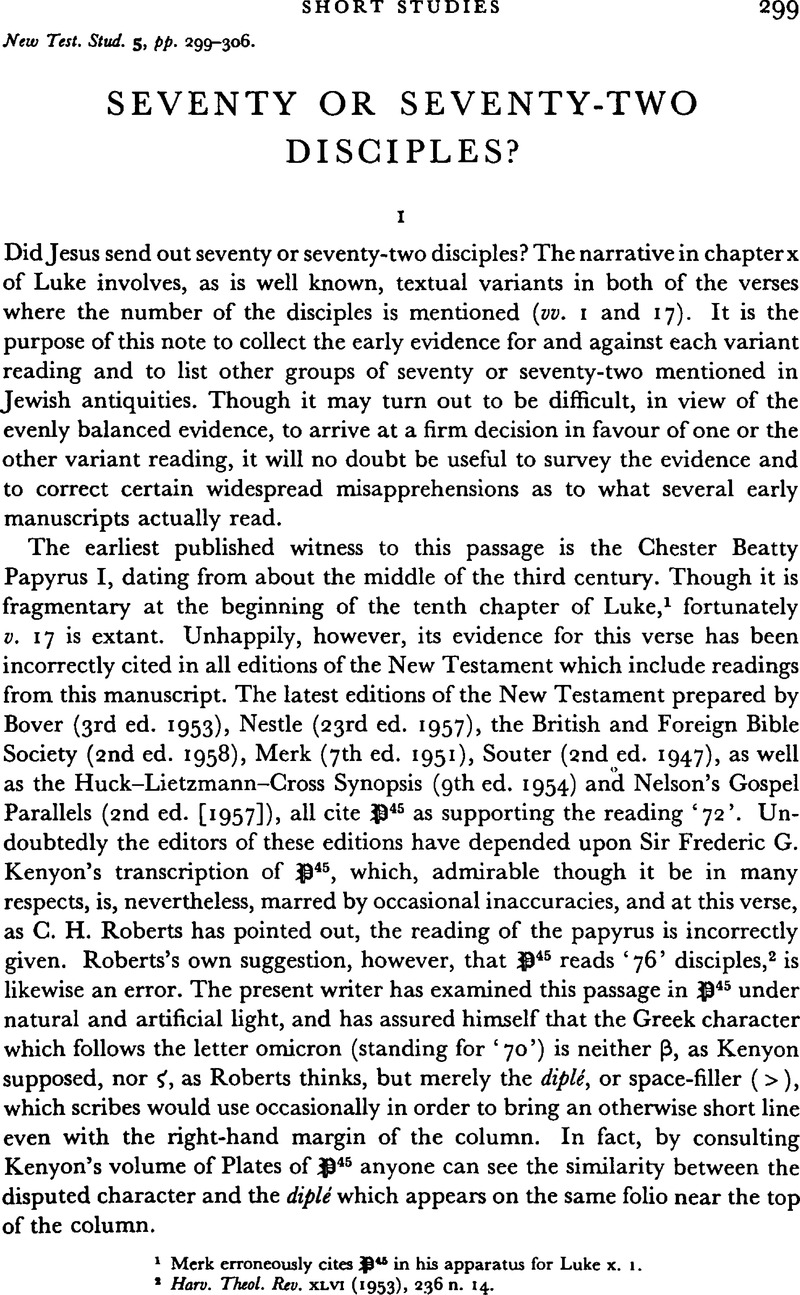Article contents
Seventy or Seventy-two Disciples?
Published online by Cambridge University Press: 05 February 2009
Abstract

- Type
- Short Studies
- Information
- Copyright
- Copyright © Cambridge University Press 1959
References
page 299 note 1 Merk erroneously cites ![]() 45 his apparatus for Luke x. 1.Google Scholar
45 his apparatus for Luke x. 1.Google Scholar
page 299 note 2 Harv. Theol. Rev. XLVI (1953), 236 n. 14.Google Scholar
page 300 note 1 Burkitt, F. C., Evatgelion da-Mepharreshe, 1 (Cambridge, 1904), 313.Google Scholar
page 300 note 2 Buchanan, E. S., The Four Gospels from the Codex Corbeiensis…together with…the Fleury Palimpsest (Old Latin Biblical Texts, no. v; Oxford, 1907), p. 98.Google Scholar
page 300 note 3 For an absurd debate instigated by Buchanan regarding a Latin palimpsest of the Gospels from Tarragona (which only he was able to decipher by going to the top of a sky-scraper building in New York!), see the (sometimes acrimonious) papers by Pitollet, Camille and Batiffol, Pierre in The Oldest Text of the Gospels, with an Introduction by E. S. Buchanan (New York, 1924).Google Scholar An edition of this palimpsest, prepared by Buchanan, was printed by G. P. Putnam's Sons, New York, but subsequently suppressed. See also Sanders, Henry A., ‘Buchanans Publikationen altlateinischer Texte, eine Warnung’, Z.N T.W. XXI (1922), 291–9, and publications referred to under items 384, 420, and 459–61 in the present writer's Annotated Bibliography of the Textual Criticism of the New Testament (Copenhagen, 1955).Google Scholar
page 300 note 4 In his review of Buchanan's volume F. C. Burkitt expresses a caveat: although ‘it is quite possible that he has read h correctly in Ac. xiv. 6…this startling reference to Lc. x. 17 (or rather Matt. x. 23) is not legible in the photograph, and I think still needs verification before any argument can be built upon it. In the case of a Palimpsest the old rule holds good, that in the mouth of two or three witnesses every word must be established’ (J.T.S. IX (1908), 305f.). Likewise A. C. Clark expressed himself with due caution, ‘If this reading is correct (it does not appear in Berger's transcript), I can only regard the words sicut…LX[XII] as a note which has got into the text’ (The Acts of the Apostles (Oxford, 1933), p. 248).Google Scholar
page 301 note 1 Moliter, Joseph, Der Paulustext des hl. Ephräms… (Rome, 1938), pp. 19*–24*.Google Scholar
page 301 note 2 Klijn, A. F. J., J.T.S. n.s. v (1954), 76.Google Scholar
page 301 note 3 Unfortunately the Armenian text of Ephraem is not available to me; for its testimony I depend upon Schäfers, Joseph, Evangeliendtak in Ephräms der Syers Kommentar zu den Paulinzschen Schriften (Freiburg ma B., 1917). p. 24, who refers to I Cor. xv. 7 and II Cor. viii. 22f.Google Scholar
page 302 note 1 All these have been edited by Schermann, Theodor in his Teubner edition of Prophetarum vitae fabulosae…(Leipzig, 1907), pp. 132 ff.CrossRefGoogle Scholar For a discussion of the several lists, see Lipsius, R. A., Die apokyphen Apostelgeschichten und Apostellegenden, 1 (Braunschweig, 1887), 193 ff.Google Scholar
page 302 note 2 See Papadopoulos-Kérameus, Athanasios, ed., Manuel d'iconographie chrétienne… (St.-Pétersbourg, 1909), pp. 151–3; another list is given on pp. 298f.Google Scholar
page 303 note 1 On rabbinic legends as to how Moses selected seventy out of the twelve tribes without incurring ill-will and envy, see [Strack]Billerbeck, , Kommentar, in loc. (vol. II, p. 166).Google Scholar
page 303 note 2 For a wide selection of rabbinic comments, see [Strack]Billerbeck Kommentar on Rom. i. 23 (vol. III, pp. 48–51). Furthermore, according to Appendix I to the Testaments of the XII Patriarchs (viii. 3f.), ‘When the nations were divided in the time of Phaleg…the Lord, blessed be He, came down from His highest heaven, and brought down with Him seventy ministering angels, Michael at their head. He commanded them to teach the seventy families which sprang from the loins of Noah seventy languages.’Google Scholar
page 303 note 3 See the testimonia collected by Wendland, Paul in the Teubner edition of Aristeas (Leipzig, 1900), pp. 90–166.Google Scholar For a still wider-ranging list of references in the Fathers, see Oikonomos, Constantine, ![]() II (Athens, 1845), 268–85.Google Scholar
II (Athens, 1845), 268–85.Google Scholar
page 304 note 1 Gloss on Bemidbar Rabba, Sect. 21 (quoted by Lightfoot, J. on John vii. 37, in Horae hebraicae et talmudicae, III (Oxford, 1859), 320).Google Scholar
page 304 note 2 For a list of other (mostly still later) instances of groups of seventy, see Steinschneider, Moritz, ‘Die kanonische Zahl der muhammedanischen Secten und die Symbolik der Zahi 70–73, aus jüdischen und muhammedanisch-arabischen Quellen nachgewiesen’, Z.D.M.G. IV (1850), 145–70;Google Scholar and ‘Nachtrag’, ibid. LVII (1903), 474–507. Much of the material collected by Saintyves, P. in Deux mythes éuangélzques, les douze apôtres et les 72 disciples (Paris, 1938), is disappointingly irrelevant.Google Scholar
page 305 note 1 For the passages, see Jeremias, in Kittel, Th.W. IV, 871–8.Google Scholar
- 4
- Cited by


